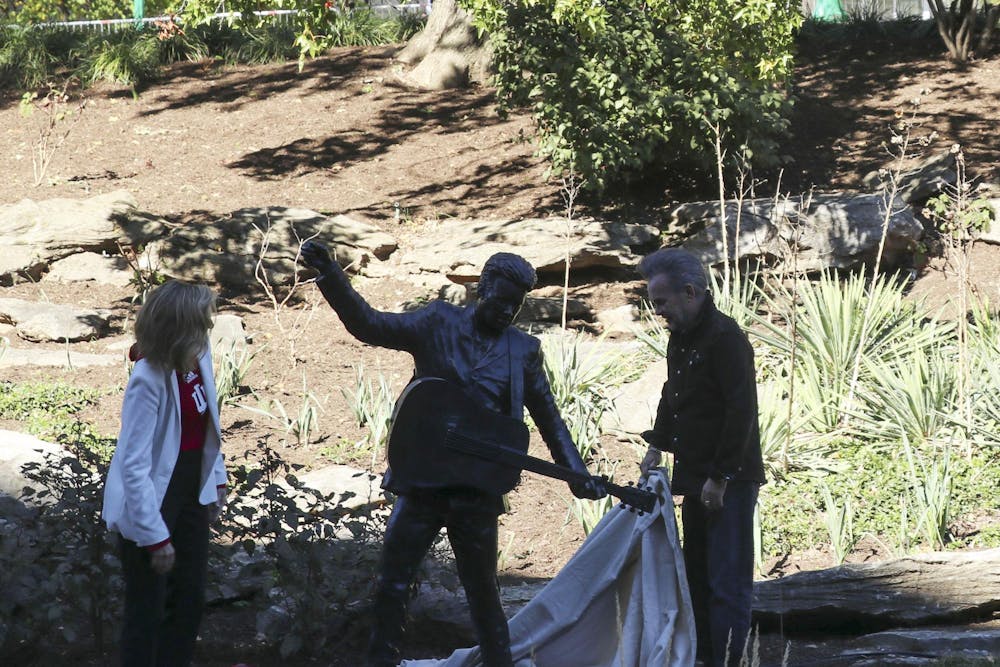IU celebrated honorary alumnus and local rock ‘n’ roll legend John Mellencamp with a new statue located on the north side of IU Auditorium during a public ceremony to commemorate the unveiling Oct. 18.
John Mellencamp, a native of Seymour, Indiana, rose to prominence in the 1980’s, offering a distinct regional sound that spoke to heartland nostalgia, as exemplified in stories of small towns and high school sweethearts in chart topping hits such as “Jack & Diane” and “Small Town.” Personified as a populist performer, Mellencamp’s streak of anti-establishment sentiment evolved from teenage rebellion and wild nights as a student at Vincennes University to championing small town family farms.
He was inspired by the subtle, yet passionate personas of 1950’s Hollywood stars James Dean and Marlon Brando who donned leather jackets and smoked cigarettes. Mellencamp’s activism was as subtle as his music. He evolved from a high school student mocked for his dyslexia to arguably one of the most powerful contributors to the zeitgeist of American literature. He makes profound social commentaries on American society with pieces such as “Pink Houses,” lamenting the plight of the common man and intimating a collective sense of camaraderie that instills a patriotism that is as layered as it is spirited.
As part of his activism, Mellencamp co-founded Farm Aid in 1985 with Neil Young and Willie Nelson, an organization dedicated to supporting locally run, family farms by combatting factory farming and supporting family farms with an annual September concert that changes location year to year.
Friday’s ceremony was attended by several hundred spectators who lined up to see the unveiling and catch a glimpse of the rock and roll legend himself.
IU Foundation President J.T. Forbes commenced the ceremony by thanking Mellencamp for championing of local farms as Forbes himself grew up on a farm in Black Hawk, Indiana.
After closing with a poem commending Mellencamp, Forbes then introduced IU alumnus and Rolling Stone Contributing Editor Anthony DeCurtis, who is involved in the curation of Mellencamp’s paintings, currently on exhibition in the Eskenazi Museum of Art.
DeCurtis emphasized Mellencamp’s status as an influential songwriter, further emphasizing his small town roots in Seymour, Indiana — a point that drew whistles from the crowd.
DeCurtis said he first interviewed Mellencamp over 40 years ago, when they made their initial connection over their shared love of Indiana. The rock critic continued to speak to Mellencamp’s candidness and disinterest in superficial publicity during their interviews.
“I never for one second had the sense that he gave the slightest thought to what would be the most advantageous thing for him to say,” DeCurtis said. “Quite the opposite. He always wanted to discuss his music and what was going on in the world, and he did so with unvarnished eloquence.”
DeCurtis also praised Mellencamp for his ability to self-reflect on his work, as well as his artistic versatility and his passion for exploring a variety of artistic mediums.
“It sometimes seems that with each album he has released, John has found a new direction,” Mellencamp said. “He’s been restless and completely uninterested in meeting anyone’s expectations but his own.”
DeCurtis concluded his speech by returning to John’s unique place in Indiana, comparing the statue of him to a gem in the midwest.
“That’s the legacy that this extraordinary statue honors,” DeCurtis said. “Anyone who encounters it will have the opportunity to experience at least partially the degree to which John’s spirit imbues this university, this town, this entire stage.”
IU President Pamela Whitten was the last to take the stage before the unveiling, praising Mellencamp for his generosity and authenticity, while also thanking him for the friendship that emerged between the two over the past few years.
Whitten additionally thanked Mellencamp for donating concert proceeds to the IU Foundation for scholarships in addition to his donation of $1.5 million in 1996 for the construction of a sports pavilion, as well as his collaboration with the university on various performances and educational initiatives, including a class of students in the Eskenazi School of Art, Architecture and Design who were able to assist in the development of the exhibition.
Whitten also noted the significance of the statue’s location in proximity to IU Auditorium, where Mellencamp has performed on numerous occasions. The statue’s creator, local Bloomington sculptor and IU alumnus Michael McAuley, also designed the sculpture of Hoagy Carmichael in 2008, adjacent to the Mellencamp statue.
“This statue will stand as a reminder of his contributions and as an inspiration to future generations of hoosiers,” Whitten said. “So thank you, John, for your music and thank you for your passion and commitment to Indiana and to the university and trust me, he is still all in for Indiana University.”
After the speeches, the moment that the crowd had gathered for had arrived. Mellencamp and Whitten pulled back the drape, unveiling the solid metal sculpture of the man himself, drawing applause from the audience as Mellencamp and Whitten looked over the sculpture together, as Mellencamp nodded at it with approval.
Later, Mellencamp spoke a few words before inviting up his four band mates for a performance.
In his remarks, Mellencamp reaffirmed his connection to Bloomington, calling it his true hometown.
“Bloomington, Indiana has been my home,” Mellencamp said. “Since I lived in London for two years and when I moved back, I moved here, and I knew I would never leave here, because it just felt like home,”
Mellencamp said he preferred the small town of Bloomington over big cities like New York, saying he feared his prospects would have dwindled with the distractions and detractions of big city living.
He ended the afternoon on a high note, performing his most cherished hits, including “Small Town,” “Rain on a Scarecrow” and “Jack & Diane.”
Jim Plum, a Seymour native, was one of those in attendance who said he believes Mellencamp’s involvement in the local community is the very reason that the honor is so well deserved.
“Because of the fact that he lives in Bloomington and has done so much for Indiana University, I think it’s a tremendous honor and a well deserved honor and I couldn’t be happier,” Plum said.
Farm Aid executive Director Carolyn Mugar was also in attendance at the unveiling. She said she believes Mellencamp’s exhibition at the Eskenazi Museum of Art serves to complement the association between his art and his activism, a defining staple of his career and his involvement in causes such as Farm Aid. Mugar said that even before Farm Aid, Mellencamp was an outspoken champion of struggling family farms.
“The art exhibit speaks to part of who he is most certainly,” Mugar said. “He spoke on what’s happening to family farmers before Farm Aid. He sort of laid the pathway for Farm Aid with his music.”
Now, the Hoosier folk rock legend will be forever cemented into the campus to which so much has been given, and to the state which will forever treasure the gem that is the legacy of John Mellencamp.
CORRECTION: This article has been updated to accurately reflect the fact that Mellencamp received an honorary doctorate from IU. Also, to accurately reflect where DeCurtis is from and with the correct spelling of McAuley's name.




